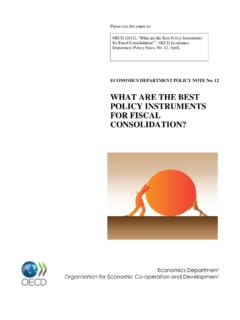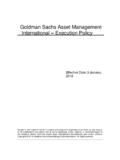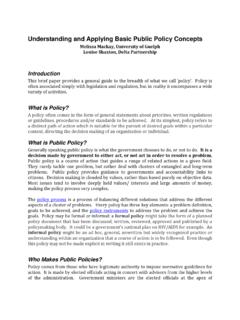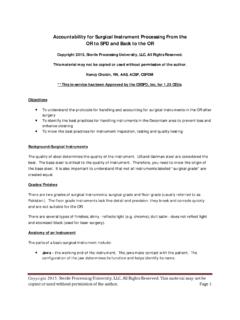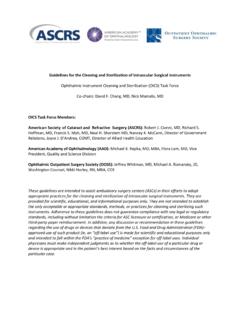Transcription of 4. Getting started: first steps in policy development
1 Getting started : first steps in policy development 23. 4. Getting started : first steps in policy development PLANNING, CAPACITY BUILDING AND COMMUNICATION. Once a decision is made to embark on policy development , successful outcomes depend on proper preparation: outlining the responsibilities of decision-making bodies; establishing the rules of engagement; drafting work plans, timetables and budgets; preparing communication strategies; and building capacity to manage the process and engage stakeholder groups in a meaningful way. Basic reference data and information should also be compiled and relevant analysis initiated. There is no escaping the fact that participatory processes take longer and cost more than traditional in-house policy development carried out by government agencies alone.
2 However, the benefits A participatory policy development process is over the long term are significant. A. costly, but not having one will cost even more. detailed work plan must be prepared and time, staff and budget set aside for joint efforts such as task forces, briefings and workshops. These requirements were frequently overlooked in the past;. often consultations were superficial and involved only those who could afford the time and had the funds. As might be expected under this scenario, few new ideas emerged and the public showed little enthusiasm for or commitment to the changes. If policy -makers want people to implement the policy , they must involve people in its development . Three factors have a major influence on work plans and timelines: the number of stakeholders; the importance and diversity of forest management and administrative arrangements; and the information available on regional and local policy as well as on legal, economic, environmental, technological, ecological and social issues and trends.
3 This last aspect mainly relates to the resources and time needed to conduct reviews and analyses at the beginning of or during policy development . Some processes to develop or reformulate policy have taken around or somewhat more than a year ( Angola, El Salvador, Latvia, Liberia, The Former Yugoslav Republic of Macedonia, Timor Leste), but sometimes it has taken two to three years to complete studies and conclude negotiations ( Australia, Austria, Finland, Jordan, Turkey, Uzbekistan, Viet Nam). While short processes might fail to involve stakeholders to a sufficient degree for the policy to be broadly understood and accepted, those that take longer than 12 to 18 months run the danger of losing momentum. No matter what process is followed, policy formulation generally consists of certain steps that need to be considered in planning work, time and budget.
4 24 Developing effective forest policy (+)74' . 'ZCORNG QH C YQTM UEJGFWNG HQT C HQTGUV RQNKE[ FGXGNQROGPV RTQEGUU. 0 CVKQPCN HQTWO 0 CVKQPCN HQTWO (QTGUV RQNKE[ . +PEGRVKQP RQNKE[ KUUWGU RQNKE[ UVCVGOGPV. GXGPV CPF UVCVGOGPV GPFQTUGF D[ . QDLGEVKXGU XGTKHKECVKQP 2 TKOG /KPKUVGT. 4 GIKQPCN . YQTMUJQRU VQ. KFGPVKH[ RQUUKDNG . 4 GIKQPCN YQTMUJQRU VQ UVTCVGIKGU . KFGPVKH[ RTKQTKV[ RQNKE[ CPF CEVKQPU. KUUWGU CPF QDLGEVKXGU. &TCHVKPI. /QPVJ /QPVJ /QPVJ /QPVJ . 5 WRRQTV UVWFKGU TGXKGYU . TGNCVGF VQ RTKQTKV[ RQNKE[ KUUWGU. 2TG NCWPEJ. HQTGUV NCY TGXKGY. FKCIPQUKU CPF. HQTGUV KPUVKVWVKQPU TGXKGY . EQPUWNVCVKQPU. GEQPQOKE VGEJPKECN CURGEVU . %QOOWPKECVKQP ECORCKIP. %CRCEKV[ DWKNFKPI ECORCKIP. Figure 4 outlines the work plan of a hypothetical 18-month process to develop forest policy , similar to that used in Syria.)]]]]]]]]]]]]
5 After inception of the process, regional workshops are held to engage stakeholders in diagnosing constraints and opportunities as well as to learn about local issues and views. The results of discussions are then raised in a national forum. In parallel to the undertaking of a number of expert studies, a second round of regional workshops are convened to devise possible strategies and actions. Draft policy statements are then written and discussed, again in a national forum, to reach agreement and seek endorsement by the Head of State. All the while, efforts are made to communicate the process to those involved, raise their awareness and build their capacity. The importance of clear and transparent communication during the policy development process cannot be overstated. It is an essential ingredient of any multi-stakeholder dialogue because effective communication: x creates an open and inclusive national dialogue on policy options.
6 X manages expectations;. x promotes transparency and accountability;. x establishes and maintains momentum;. x promotes a culture of public dialogue, not only between citizens and government, but also between citizen and citizen, business and business, and citizen and business. Getting started : first steps in policy development 25. There are many ways to communicate with and involve stakeholders and the wider public, including Internet (dedicated Web sites), mobile telephone, radio, commercial or State television, village assemblies, town hall meetings and theatre. Experience shows that communication systems at the community level are the most effective for reaching local people. Building capacity to facilitate and strengthen the involvement of different stakeholders is an integral part of many forest policy development processes; for example, in Latvia, Serbia, Turkey and Uzbekistan, all working group members were trained to use a participatory approach to policy development from the onset.
7 Capacity building not only improves Topics can include the concept and rules of understanding of the concept, it also contributes to team building and participatory policy development processes, strengthens personal commitment to the sharing experiences with participation in process essential conditions for success. similar processes elsewhere, the role of data and information on situation and trends, identifying common interests, developing strategies, establishing mechanisms for constructive communication and feedback, identifying and building advocacy coalitions, lobbying to reach acceptable solutions and enhancing negotiation skills. Planning for capacity-building calls for an assessment of who requires training to be able to participate effectively and of the best means to deliver it, through workshops at the beginning of the process or through specific coaching.
8 PREPARATORY ANALYSIS: PROVIDING KEY BACKGROUND INFORMATION. Sound and credible information and data on a range of topics are needed in order to engage stakeholders meaningfully in discussions such as workshops or bilateral consultations. At the outset, it is beneficial to compile and review existing information, conduct studies and Perception drives politics. policy collect data on forests, their management and discussions need to be based on the best use, as well as on the context within which available data on key aspects. they are governed. The depth of the analysis depends on the circumstances, the resources and the time available for a review. It is necessary to prepare relevant, statistically sound and unbiased information that can be made available in discussions, on subjects such as: x forest resources, their uses and management ( from national forest inventories or assessments).
9 X situation and trends in the forest sector, political, societal and demographic trends, and economic and technological developments ( from sectoral and outlook studies and public opinion surveys);. x past and current policies, legislation and strategies relevant to forests, including those pertaining to national development , economic and sustainable development , agriculture and energy;. x land use, land use planning, landownership, land tenure and related policies and legislation;. x institutional arrangements and capacities;. 26 Developing effective forest policy x key national forest policy issues such as deforestation, forest tenure and access, illegal logging, carbon sequestration and fire;. x international commitments related to forests. Often, the necessary information and studies are already available.
10 In many other cases, reviews must be undertaken in key areas such as policies or legal and institutional frameworks, as has been done, for example, in Algeria, Benin, the Comoros and Jordan. Alternatively, technical experts can be invited either to participate in the process or to make presentations at workshops or other forums. It is particularly important to recognize the importance of wider political, socio-demographic, economic, technological and environmental trends and predicted future scenarios, as these determine A new policy needs to give guidance on and influence how forests will be used and anticipated, not past, conditions. Future conditions need to be in focus when a the context within which forests will have to new policy is being developed. be managed. Many countries have conducted studies or consultations on the outlook for the forest sector (Box 7), some with support from FAO.










